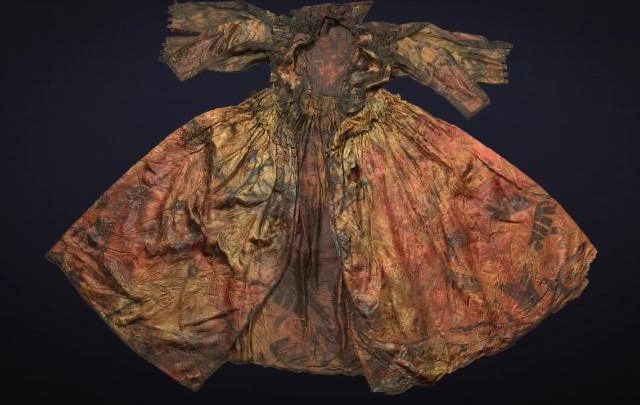
Nadine Akkerman finds out who owned wardrobe recently discovered in the Wadden Sea
21 April 2016Scottish lady-in-waiting
The now famous silk gown is still remarkably well preserved and is the showpiece of a larger archaeological find near Texel. It probably belonged to Jean Kerr, Countess of Roxburghe (c. 1585-1643), lady-in-waiting and confidante to Queen Henrietta Maria (1609-1669). Jean was one of two ladies-in-waiting whose clothes went down with the ship, but the style and size of the gown indicates strongly that it belonged to Kerr, the elder of the two.
Elizabeth Stuart
Cultural historians Nadine Akkerman and Helmer Helmers are experts on the British Royal House of Stuart. Their findings are based on a letter written by Elizabeth Stuart (1596-1662), the Stuart princess who found refuge in The Hague after being exiled from the Kingdom of Bohemia. In a letter to the English diplomat Sir Thomas Roe, dated 17 March 1642, Elizabeth describes how her sister-in-law lost a baggage ship during the crossing. In addition to the clothing of two ladies-in-waiting and their maids, the queen herself lost the ‘vessels’ from her private chapel in the shipwreck.
A secret mission
The official story behind Henrietta Maria’s trip to the Dutch Republic was one of royal connections: she was delivering her 11-year old daughter Mary to the court of William II, Prince of Orange and future stadtholder, whom the girl had married the previous year. This was only a ruse, however: her real mission was to sell the crown jewels and use the proceeds to buy weapons. These were essential for King Charles I to take on Parliament in the English Civil War. According to Akkerman and Helmers, the find at Texel represents a tangible reminder of the strong Dutch involvement in this conflict.
Winter Queen
Akkerman, assistant professor of Early Modern English Literature at Leiden University, and Helmers, assistant professor of Early Modern Dutch Literature and Culture at the UvA, were able to solve the mystery of the unknown gown owner reasonably quickly. Akkerman: ‘Once Helmer alerted me to the find, it took us about five minutes to unearth the relevant letter, as I remembered transcribing and deciphering it in 2006. We continue to find more references.’
Akkerman is the editor of the Correspondence of Elizabeth Stuart, Queen of Bohemia, while Helmers is the author of The Royalist Republic, on Anglo-Dutch relations in this period.
Unnecessary speculation
The mystery and speculation in the Dutch press surrounding the origin of the wardrobe were unnecessary. With the discovery of the family crest, the evidence quickly started pointing towards the Stuarts. Helmers: ‘It is a pity we weren’t consulted earlier – the puzzle would have been solved much earlier. The archeological experts have primarily focused on the material side. Of course this is important, but the historical texts also tell a thrilling story.’
Source: University of Amsterdam
More
“Was eigenaresse van gevonden garderobe uit Gouden Eeuw een spion?” (De Volkskrant)
Secrets of 17th-century postal archive finally to be revealed (more research by Akkerman)
Wathc the Dutch television programme “Kennis van Nu” with an item on Akkerman’s discovery of the Brienne piggy bank
Akkerman on Espionage Techniques of 17-th century Women
Watch the Dutch television programme “Kennis van Nu” with an item on Akkerman’s study of espionage techniques
Encoded correspondence (on Akkerman’s most recent publication on Elizabeth Stuart)
Ciphers and codes in the letters of female spies (on previous work by Akkerman)



